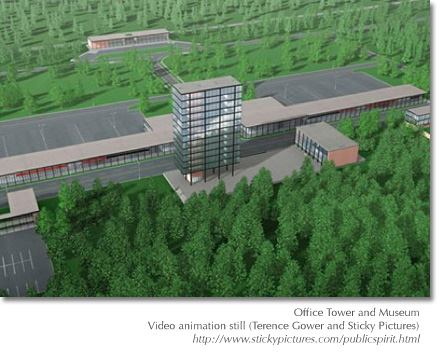Exhibit: the Hirshhorn Ontario Townsite and a 1950s Utopian Vision for Art and Industry in the Canadian Wilderness
by admin ~ November 29th, 2008

A new exhibit at the Hirshhorn Museum in Washington, D.C., “Public Spirit: The Hirshhorn Project” (November 05, 2008 – March 22, 2009), draws on a unique tale of adventure and discovery in Western Ontario, and a series of plans and photos for a utopian settlement blending modern design, contemporary art, and private philanthropy in the Canadian Wilderness. Joseph H. Hirshhorn made a small fortune on Wall Street in the 20s, struck it rich in the booming gold and uranium fields of Ontario in the 1950s, and was an avid collector of contemporary art and works by Man Ray, Josef Albers, Irene Rice Pereira, Victor Vasarely, and others (acquiring up to two works/day in the 1950s). In search of a home for his collection, he contracted Philip Johnson (head of architecture at the Museum of Modern Art) to design a town site in Western Ontario, north of Lake Huron, which he described as a “town of culture” and a thriving mix of industry, art, education, entertainment, healthy living, and nature.
The new city was to achieve a harmonious balance between labor and leisure, providing miners with housing and a museum, sculpture park, theater, concert hall, and library. Unlike other privately funded industry-specific towns, it would have had a unique focus on arts and culture, access to advances in psychological therapies, and a highly aestheticized design throughout. The project never came to fruition, but documentation of Johnson’s models and plans remain. Taking this forgotten historical footnote as his subject, New York-based Canadian artist Terence Gower, whose works often focus on detecting shifts in ideology through architecture, presents “Public Spirit – the Hirshhorn Project.” The multimedia installation incorporates photographs of the original maquettes, new models of Johnson’s design created by Gower, and a digitally animated video projection, which leads visitors through the imagined town. Gower likens the planned town and its likewise utopian predecessors to “little quasi-socialist planets within a capitalist universe” (1).
The work includes a variety of archival materials, a scale model of the town plan, and an animated video tour (produced in collaboration with Sticky Pictures). Display cases provide background materials on the uranium industry, correspondence about the plan (including letters to U.S. President and Ladybird Johnson), and information about Hirshhorn’s art collection (relatively unfiltered by interpretation and analysis). The video is a serene and precise reflection of the integrated town design, which one reviewer described as “so well rendered it almost looks alive.” You can view a short two minute section of the video on-line. The creator of the work, Terence Gower, is a Canadian artist residing in New York, and recently held an Artist Research Fellowship at the Smithsonian Museum. The exhibit runs from now until March 22, 2009, at the Hirshhorn Museum.
More Information:
- Joseph H. Hirshhorn: Canadian Mining Hall of Fame and Wikipedia.
- Hirshhorn Museum: exhibit site, sample video, Hirshhorn Fall 2008 Magazine (PDF).
- Archival newspaper clippings: “The New Uranium King” (Feb. 21, 1955), “Billion-Dollar Empire” (Aug. 01, 1955), “Picasso Finds New Home in Ontario Wilderness” (July 30, 1955).
- Reviews: “Northern Disclosure; Hirshhorn Looked Into the Wild for A Place to Build His Museum” (Nov. 10, 2008), e-flux (Nov. 12, 2008), “A lost art oasis in Northern Ontario” (Nov. 25, 2008), “New Town in Canadian Wilderness by Philip Johnson” (Nov. 27, 2008).
.jpg)